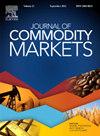Hedging shipping freight rates using conditional Value-at-Risk and Buffered Probability of Exceedance
IF 4.5
4区 经济学
Q1 BUSINESS, FINANCE
引用次数: 0
Abstract
This paper investigates the performance of the minimum Conditional Value-at-Risk (CVaR) hedging technique in the dry bulk shipping freight market, where extreme volatility and asymmetric return distributions often limit the effectiveness of traditional minimum variance approaches. The CVaR-based framework is used to minimize the downside tail risk in both static and dynamic hedging settings using a dataset of Forward Freight Agreements (FFAs) for Capesize, Panamax and Supramax vessels over the period of January 2007 to December 2022. Our results suggest that the effectiveness of alternative hedging strategies is sensitive to the distributional shape of the underlying returns, underscoring the suitability of CVaR-based strategies under heavy-tailed and skewed returns. Furthermore, we introduce a probabilistic optimization framework that minimizes the Buffered Probability of Exceedance (bPOE), subject to a pre-specified CVaR constraint. This dual-risk formulation yields an efficient frontier, i.e., a set of optimal solutions between risk and return, that quantifies the trade-off between the likelihood and magnitude of extreme losses, ultimately enhancing hedging performance and offering insights into tail risk management.
使用条件风险价值和缓冲超出概率对冲航运运价
本文研究了最小条件风险值(CVaR)套期保值技术在干散货航运市场中的表现,其中极端的波动性和不对称的回报分布往往限制了传统最小方差方法的有效性。基于cvar的框架使用2007年1月至2022年12月期间好望角型、巴拿马型和超重型船舶远期运费协议(FFAs)数据集,用于最小化静态和动态对冲设置中的下行尾部风险。我们的研究结果表明,替代对冲策略的有效性对潜在收益的分布形状很敏感,强调了基于cvar的策略在重尾和倾斜收益下的适用性。此外,我们引入了一个概率优化框架,该框架在预先指定的CVaR约束下最小化缓冲超出概率(bPOE)。这种双重风险公式产生了一个有效的边界,即风险和回报之间的一组最优解,量化了极端损失的可能性和程度之间的权衡,最终提高了对冲绩效,并提供了对尾部风险管理的见解。
本文章由计算机程序翻译,如有差异,请以英文原文为准。
求助全文
约1分钟内获得全文
求助全文
来源期刊

Journal of Commodity Markets
Multiple-
CiteScore
5.70
自引率
2.40%
发文量
53
期刊介绍:
The purpose of the journal is also to stimulate international dialog among academics, industry participants, traders, investors, and policymakers with mutual interests in commodity markets. The mandate for the journal is to present ongoing work within commodity economics and finance. Topics can be related to financialization of commodity markets; pricing, hedging, and risk analysis of commodity derivatives; risk premia in commodity markets; real option analysis for commodity project investment and production; portfolio allocation including commodities; forecasting in commodity markets; corporate finance for commodity-exposed corporations; econometric/statistical analysis of commodity markets; organization of commodity markets; regulation of commodity markets; local and global commodity trading; and commodity supply chains. Commodity markets in this context are energy markets (including renewables), metal markets, mineral markets, agricultural markets, livestock and fish markets, markets for weather derivatives, emission markets, shipping markets, water, and related markets. This interdisciplinary and trans-disciplinary journal will cover all commodity markets and is thus relevant for a broad audience. Commodity markets are not only of academic interest but also highly relevant for many practitioners, including asset managers, industrial managers, investment bankers, risk managers, and also policymakers in governments, central banks, and supranational institutions.
 求助内容:
求助内容: 应助结果提醒方式:
应助结果提醒方式:


